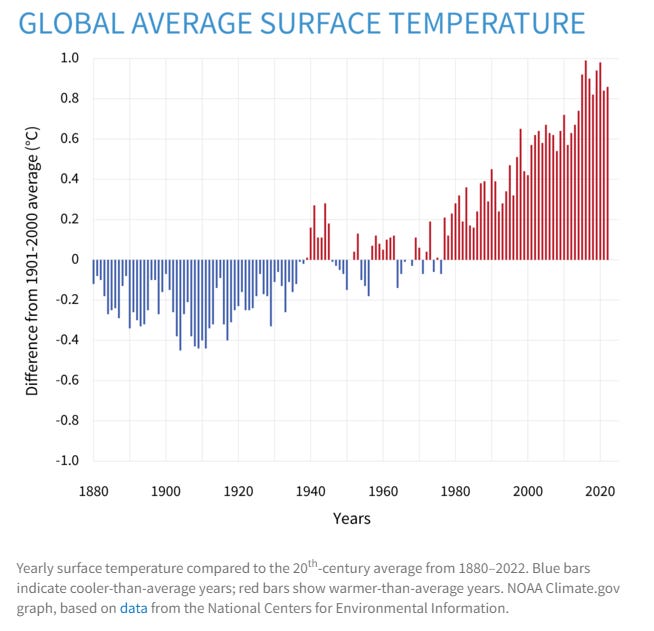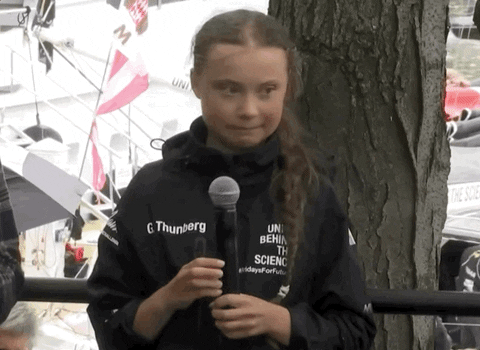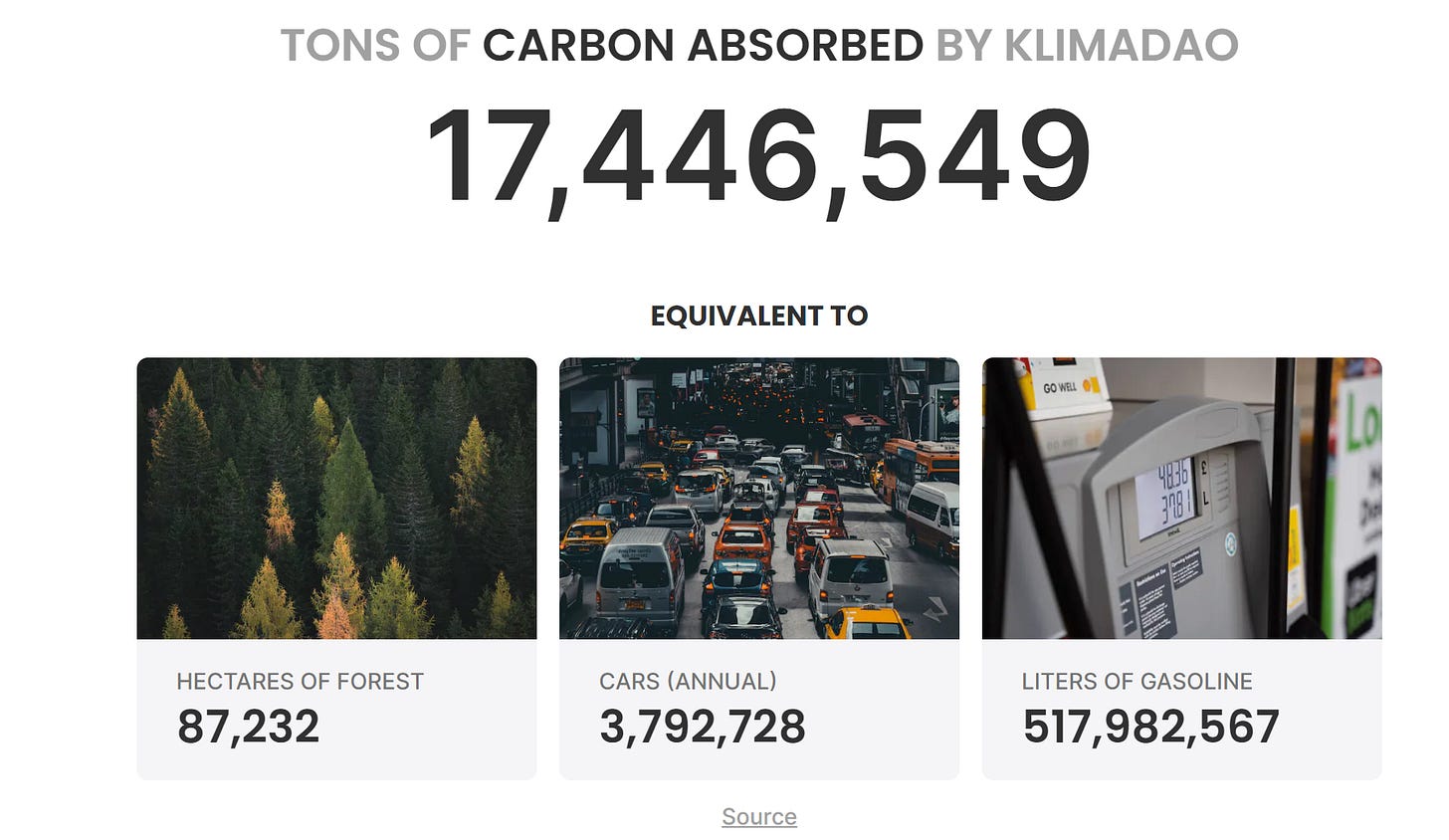Klima DAO: Is Global Warming Real?
A DAO that even Greta Thunberg would be happy to join
This question has surprisingly been asked in abundance over the last 200 years with skeptics voicing their distaste for those that espoused the catastrophic consequences of global warming on the world and the need for action to combat it. The origins of climate change go all the way back to the 1820s when physicist Joseph Fourier proposed a theorem that energy reaching the planet from the sun must be balanced by energy returning to outer space due to heated surfaces emitting radiation. However, he also suggested some of the returning energy would be held within Earth’s atmosphere similar to a warm greenhouse. Further experiments throughout the 19th century confirmed carbon dioxide (CO2), and specifically coal gas, acted like a sponge by absorbing various wavelengths of sunlight. Swedish chemist, Svante Arrhenius, in the 1890s, would posit that the level of CO2 in the atmosphere directly affects the temperature on Earth.
As the world transitioned from manual labor and farming during the agricultural revolution to leveraging fossil fuels and machinery in the industrial revolutions the amount of CO2 in the atmosphere exponentially increased. In the 1930s, amidst the second industrial revolution, scientists would start to claim that global warming has already taken effect and altered the temperature on Earth. You can see this transition take place in the image below with average surface temperature starting to increase around 1940 - 2001.
Almost every country and government is talking about how they plan on transitioning to renewable energy and being carbon neutral by some ambitious timeline that is ostensibly not feasible.
Carbon Credits
In 1997, carbon trading formally started under the United Nations Kyoto Protocol which had more than 150 nations sign on. Participating nations agreed to limit their greenhouse gas emissions and enable emissions trading for countries and companies to sell excess carbon credits, in the form of permits, to others that had levels well over their limit. This essentially set up a market for carbon credits with financial incentives for being eco-friendly.
The carbon credit is half of a so-called cap-and-trade program. Companies that pollute are awarded credits that allow them to continue to pollute up to a certain limit, which is reduced periodically. Meanwhile, the company may sell any unneeded credits to another company that needs them. Private companies are thus doubly incentivized to reduce greenhouse emissions. First, they must spend money on extra credits if their emissions exceed the cap. Second, they can make money by reducing their emissions and selling their excess allowances.
There are 2 different carbon credit markets:
Compliance - governed by public policy in individual countries
Voluntary - voluntary carbon market (VCM) is international and governed by institutions that determine the certification criteria
The voluntary carbon credit market has grown significantly in recent years as policy and regulation shifts across the world are increasing demand for carbon emission credits.
There are several governmental organizations around the globe that monitor carbon emissions but as you can imagine it is a difficult task for both the compliance and voluntary markets. Many companies do not want to endure the financial penalty for surpassing their carbon emissions limit so they will underreport or offshore emissions to a different country so it isn’t accounted for. These issues along with problems in carbon credit markets around liquidity, transparency, and inefficiencies between buyers and sellers highlighted the need for an alternative solution. Now, let us take a look at the DAO that even Greta Thunberg would be proud to be a part of.
Klima DAO
KlimaDAO launched on October 18th, 2021, with a vision to scale the impact and efficiency of climate finance globally through building transparent, neutral, and public infrastructure for the carbon market.
As the market for carbon credits quadrupled from 2020 to 2021, this was the perfect time to launch new innovative infrastructure to handle the burgeoning carbon credit market. Utilizing blockchain’s characteristics of transparency, disintermediation, and low-cost transactions Klima DAO is attempting to fix the inefficiencies that the market is facing.
KlimaDAO infrastructure prioritizes accessibility and transparency across the value chain of the carbon markets:
Project developers can access the infrastructure to immediately find counterparties for their carbon credits.
Those looking to acquire carbon credits can do so efficiently and securely using Web3 tools.
To claim the environmental benefit of any carbon credits, KlimaDAO’s retirement infrastructure enables this to happen with no reliance on intermediaries.
Anyone who holds tokens, can participate directly in the governance of the system.
How Does It Work?
Klima allows individuals or businesses to purchase $KLIMA tokens that represent a ton of carbon dioxide that has been offset by verified carbon reduction projects. Projects can consist of anything from reforestation to renewable energy initiatives.
But, Who Verifies These Carbon Credit Projects?
Across the world there is an abundance of initiatives aimed at combatting global warming and carbon dioxide emissions, but how do you separate the real projects from the scam artists? The Verified Carbon Standard (VCS) is a non-profit organization established in 2005 by a group of NGOs and environmentally friendly industry associations. VCS is a rigorous certification program that verifies and validates carbon reduction projects worldwide, ensuring they live up to industry and environmental standards.
$KLIMA Token
Each $KLIMA token is backed by at least 1 ton of VCS-verified carbon credits from protocols that are building infrastructure for tokenizing carbon credits. Some examples include:
Base Carbon Tonne (BCT)- accepts all carbon credit types (solar, wind, nature-based) and within 2 months of launch they tokenized over 15 million carbon credits
Nature Carbon Tonne (NCT) - only accepts carbon credits that use nature-based methodologies
UPCO2
Each of these protocols tokenized real-world assets, in this case a ton of carbon that is VCS verified and brought them onto the blockchain. For each $KLIMA token in existence, there is a tokenized ton of carbon credit in the treasury which helps sustain Klima’s economy.
The core principle of the KlimaDAO ecosystem is that a KLIMA token can only be minted by the treasury if at least 1 tonne of carbon like a BCT (or other) is deposited in the treasury.
Because every BCT is covered by a carbon credit that guarantees the mitigation or removal of 1 tonne of carbon, this system is built on, and internalises carbon.
KLIMA's value is connected with the value of the BCT (or other digital carbon tokens) locked in the KlimaDAO treasury; it is fair to say that on-chain carbon and the carbon offset value will be subject to market events.
Longer-term participation in the Klima ecosystem will be incentivised by key protocol mechanisms:
So, How Does This Help The Environment?
Every time a business or individual buys the $KLIMA token the funds are used to buy a tokenized carbon credit that is then put into the DAO’s treasury, essentially taking that ton of carbon out of the market. When someone decides to sell their token they are just transferring ownership of that carbon credit to someone else.
By utilizing blockchain technology Klima DAO provides the market with an efficient disintermediated market that is completely transparent and tamper-proof.
There are currently 25,000 holders of the $KLIMA token and it currently trades at ~$2 with a ~$17M market cap (source).
To date, Klima DAO has accomplished significant feats with 17.4M tons of carbon absorbed!
These are incredibly impressive numbers for a DAO that has been around for less than 2 years. Klima DAO has a growing community of 68k Twitter followers, and 35k Discord members and we expect that number to continue to grow. This a perfect example for the crypto and blockchain skeptics that detest the industry for not having any practical use cases!
Learn More!






